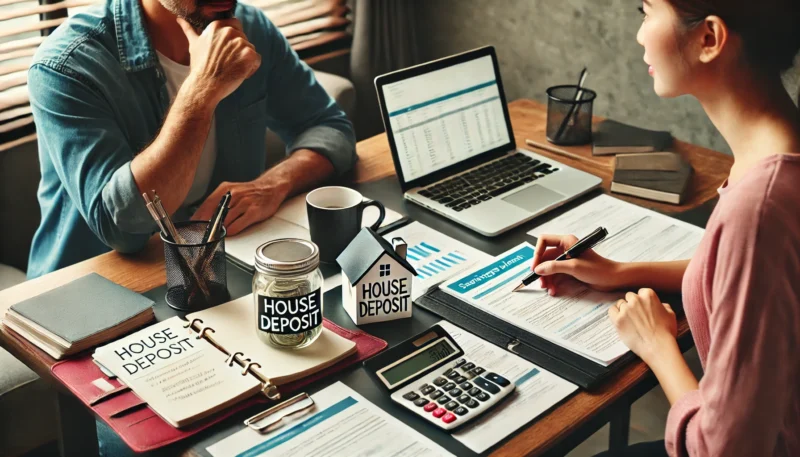Buying a house is one of the most significant financial decisions you'll make in your lifetime, and it's a decision that should involve lots of research and planning to ensure you’re making the best decision.
To help you navigate the process, I’ve put together a 10-step guide.
From setting your budget to gathering your team, searching for your property, and even making an offer, this guide will give you everything you need to buy a home in Australia.

Note: First, at Metropole, we firmly believe you should start with the end in mind, and that's why before even talking about a property we always help our clients build a customised personalised strategic property plan. to ensure their home-buying journey fits in with their long-term financial goals.
Then, these are the steps you should take when buying a home…

Step 1: Decide what your goals are
Before diving into the property market the first step for any property buyer - homeowner or investor - is to take the time to clarify your goals and set a realistic budget.
Start by reviewing your current situation, then look at how much you are willing, or are able to spend.
Think about your reasons for buying
First up, what is the reason you want to buy a home?
Are you renting and want to take the next step?Have you outgrown your current home and want to upgrade?
Or is the opposite true and you want to look for something smaller? That’s called “right-sizing” nowadays.
Or perhaps you’re an investor looking for your first or next investment property?
Whichever it is, you need to have a good handle on what the driving force behind your home-buying decision is.
Obviously this is what will help guide you later on when it comes to picking the right property.

Tip: Remember, sometimes staying put can become the better option, because, while the numbers are important, depending on your job and job prospects, you might be better off with the flexibility that renting offers.
Decide what you can afford
The next thing to think about is your finances - how do they stack up?
Assess your savings, income, expenses, and borrowing capacity.

Note: Ideally, you’ve already saved 20% for a deposit, although as little as 10% is also acceptable in some cases if you’re willing to pay the additional lenders’ mortgage insurance (LMI).
What you can borrow depends not only on the size of the deposit saved but also on your income, financial situation, repayment history, total expenses, and any other debts or assets.
When it comes to buying a home, one of the many online home or investment loan borrowing calculators can help determine how much a lender will give you. These are not accurate but will give you a rough indication.
For example, a borrower on a $100,000 annual gross income may be able to afford to borrow around $501,000 at a 6.94% interest rate, but slash that to $179,000 if for an income of $50,000.
Step 2: Identify the type of property you want to buy
The next step is to work out what you’re looking for in your budget.
Whether you’re looking for a family home or your next investment property, the following 3 things need to be a high priority.
Your ‘must-haves’ and ‘nice-to-haves’
There is a difference between what you would like to have in a property and what is critical to have.
So, it’s important to note the distinction between the two when buying a home.
Some things are obviously non-negotiable but that will depend on your current situation and the stage of life you’re in.
Your ‘must-haves’ may include things such as the number of bedrooms, property size, location, layout, and local amenities, whereas your ‘nice-to-haves’ may include things such as design, outdoor space, and renovation potential.
For example, a one-bedroom apartment does not make sense for a growing family, and while a large garden would be preferable, any type of outside space would likely suffice.
Property type and size
Aside from the ‘must-haves’ and ‘nice-to-haves’ you also need to work out what type of property will suit you and fit into your budget.
This will help you know what to look for.
An apartment or a townhouse might suit your needs, or you might want to look for a detached dwelling or even vacant land so you can build your own property.
And how many bedrooms or bathrooms do you need?
Do you need a property with room to grow?
Do you need an office area if you plan to work from home?

Note: The size of the property you want to buy is also important because this can help significantly reduce the number of eligible properties in your property search.
The right location
Location plays a vital role in the value of a property.
I always say that location does 80% of the heavy lifting of a property’s capital growth.
So, you need to identify areas that have the potential for capital growth, offer good infrastructure, and suit your lifestyle needs.

Tip: Consider factors like proximity to schools, healthcare facilities, public transport, and local amenities.
Finding the best property in the best location needs to be your ultimate goal.
There is no point in setting your heart on a four-bedroom house in the perfect location if it is going to be too far out of your price range.
Likewise, you probably don’t want to buy a house in your budget that ticks all the boxes but is in the middle of nowhere with no amenities or transport links and isn’t close to your place of work.
Hone in on a suburb that is appealing to you and choose a property from there.
Step 3: Put together your team of experts
Next, you need to seek guidance from some professionals.
The following categories should help you start out on the right track.

Buyer’s agent
A buyer’s agent works solely for the buyer by finding suitable properties and assisting them through due diligence, negotiation, auction bidding, and the purchase of their property.
As someone who has thorough insight into the local market, a buyer’s agent can be a handy tool for anyone planning on buying property in Australia.
A solicitor or conveyancer
Engage a solicitor or conveyancer to handle the legal aspects of the property transaction.
They will review the Contract of Sale, conduct necessary searches, liaise with the lender, and manage the exchange of contracts.
Mortgage broker
Having a pre-approved loan can give you a competitive edge, as it signals to sellers that you're a serious buyer.
It helps you make an offer that is not subject to finance.
So engaging a finance broker is a valuable resource when buying property in Australia because they can help you to find the most appropriate loan products for your financial situation, and they can also negotiate with lenders on your behalf, ensuring a smooth process of buying a property.
Step 4 - Plan your finances
You’ve worked out what you can afford to borrow and what you’re looking for and have enlisted help from the experts… Now, it's time to officially plan your finances.

Save for a house deposit
As I mentioned above, you should have already saved for a house deposit—ideally 20%, but some lenders accept as little as 10% if you’re willing to pay the additional LMI fee.
You also want to ensure you have enough to cover the buying costs, such as your buyer’s agent commission, pest and building inspections, stamp duty, legal and conveyancing fees, and finance and insurance costs.
Get home loan pre-approval
You should always get pre-approval from a lender before you start house hunting.
This is essentially a “conditional” loan approval, which will depend on the property you eventually want to purchase.
It will usually last for around 3-6 months, but it shows that you're eligible to obtain a loan up to a certain amount.
However, there is no commitment to apply for the loan.
What pre-approval does is give you confidence in your budget during the process of buying a home and also signals to real estate agents that you are a serious buyer.
Step 5: Find a property to buy
The next step is to begin house hunting!
This is where a buyer’s agent will be invaluable in doing the research, homework, and leg work for you.
They will guide you through the buying process, negotiate on your behalf, and provide valuable advice.
They can help you find properties that fit your criteria, arrange inspections, and advise you on market trends.
They will come up with a list of potentially suitable properties and when each is open for inspection and create a plan of action for how and when to visit them all with you.

Step 6: Conduct a home inspection
You’ve now sniffed out a list of the most suitable properties in the area you want to buy, now you need to inspect them all.

Tip: Don't just look at the surface – inspect the property's structure, plumbing, wiring, and signs of pest or water damage.
If you’re serious about a property it's often beneficial to engage a professional building inspector to assess the property thoroughly.
Step 7: Negotiate the purchase price
Once you’ve found a property you’re interested in, the process of buying a home begins.
The first step is to request a contract of sale from the real estate agent, which includes information about the sale’s terms and conditions, any inclusions and exclusions, special conditions, and a copy of the property title.

Tip: You should ask your conveyancer to look over the contract of sale to check all the conditions and to check all rates and taxes are up to date.
You, or preferably an experienced negotiator like your buyer’s agent, can then begin to negotiate the purchase price with the seller’s agent.
You need to determine how high you are prepared, and are financially able, to go to secure the property.
In negotiation, don’t assume your first offer will be accepted.
More often, there will be a bit of back and forth until both parties come to an agreement.
At this point, you can also involve your conveyancer if you want to negotiate any changes to the contract as part of your offer or negotiation.
Step 8: Make an offer
Once you have negotiated and agreed on a purchase price with the seller’s agent, you’re now at the point of committing to buy the property with an official offer.
Put your offer in writing and include any conditions you agreed to or decided upon when you negotiated the price.
While this doesn’t apply to buying at auction, generally you will have a “cooling off period” which is your last chance to withdraw from buying the property without major legal or financial consequences.
What this means is you can cancel the contract during the cooling-off period, but as regulations vary from state to state you may lose a portion or all of your deposit.
Depending on your state, the cooling-off period varies from 2 to 5 business days.
In some states, however, there is no cooling-off period, even for private treaty sales, so be careful and check the Fair Trading or Real Estate Institute website in your state or territory.
Step 9: Follow the settlement process
The contract of sale
Once the offer is accepted, you will sign a contract of sale with the help and guidance of your buyer’s agent and conveyancer.
There will be two copies of the sale contract: one for you and one for the buyer. You each sign one copy before they are swapped or ‘exchanged’ - today this is almost always done electronically rather than in person with the physical exchange of contracts.
At the time of the signing of the contract or sale, and exchange, the buyer will be required to pay a deposit, usually around 10% of the purchase price.
Pre-settlement inspection
A buyer is also entitled to a pre-settlement inspection, sometimes also called a final inspection, where you can check that everything listed in the sales contract is still there and that the property is in the same condition as when you signed the contract.
You’ll want to keep an eye out for any agreed repairs (to check they've been done), that all the electricals in the house still work, that there are no leaking taps, rubbish has been removed, fixtures and fittings are as agreed, that the gardens and swimming pool (if applicable) has been maintained, and that there is no new damage.
If the property is not in the same state as when you signed the contract then you’re entitled to ask the vendor to make repairs before property settlement.
Extra costs and taxes
You’ll know by now that the cost of buying property in Australia comprises more than just the purchase price and your deposit, you also need to factor in extra costs and taxes incurred when buying a home.
- Legal and conveyancing fees: Depending on what is required, you should expect to pay up to $3,000 for legal and conveyancing fees associated with buying a home.
- Finance and insurance fees: If you have less than a 20% deposit then you will be required to pay LMI, the cost of which is a sliding scale based on the value of your property and how much money you have. You also need to put aside up to $600 for a mortgage application fee and up to $500 to cover a valuation fee.
- Building and pest inspection costs: As part of the process of buying a home, it’s vital that you arrange building and pest inspections (up to around $700) and obtain a strata agreement or report (around $300) if the property is on a strata title. While there’s a fee associated with each of these, it could save you a fortune in the long run if you uncover a significant issue that isn’t obvious in the inspection.
- Stamp duty: Stamp duty is the biggest fee incurred when buying a home and occurs at the point of final settlement when the buyer pays the agreed settled sum to the seller and the title documents are exchanged. The cost varies depending on the state you live in, the purchase price of the property you buy, your current situation, and any government incentives applicable at the time.
- Buyer’s Agent commission: This fee will have been negotiated before you start your property search and should more than pay for itself as an experienced buyer’s agent can help you level the playing field and make your property buying experience better.
Step 10: Become a homeowner and start paying off your mortgage
Once the settlement process is finalised, you pay the agreed settled sum to the seller, and documents are exchanged, you're officially a homeowner.
Congratulations!
Now the only things to organise are your removalist (if you’re moving into the new property), your utility accounts and to begin paying off your mortgage.

Tip: To save interest over time, some lenders allow additional payments, or for you to make payments on a more frequent basis - it’s worth finding out how much it might save you in the long run.
Now would also be a good time to arrange home and contents insurance and update your budget with your new mortgage repayments and include any ongoing fees such as strata fees or council rates.

Note: Buying a home is an exciting yet scary prospect because you’re entering into the great unknown and outlying a lot of money.
But with the right knowledge and team behind you, you can be confident that you’re making the best financial decision to suit you and your situation.














